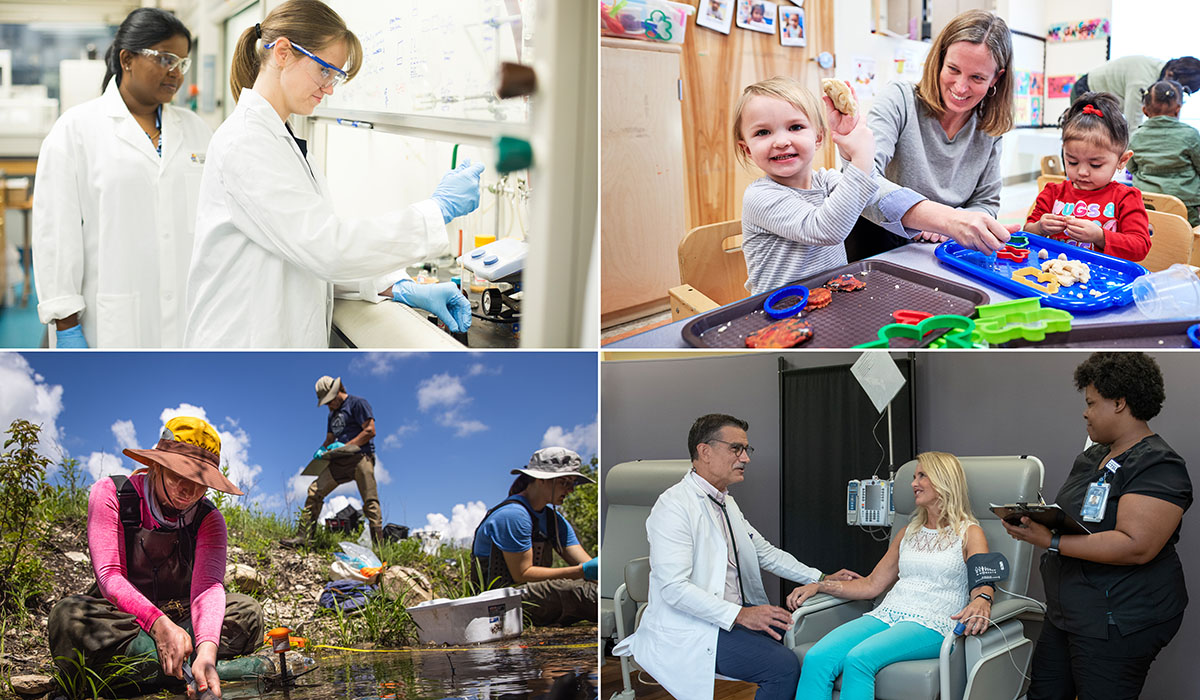KU research growth fuels Kansas economy, improves lives

LAWRENCE — Research is on the rise at the University of Kansas, and the reverberations of that growth are benefiting people across the Sunflower State and beyond.
Research expenditures spanning all KU campuses increased to $368.6 million in 2023, capping nearly a decade of steady expansion. Last year alone, externally funded research at KU supported the salaries of 4,372 people, and the university spent $78.9 million in 97 Kansas counties on research-related goods and services, according to a report from the Institute for Research on Innovation & Science. Vendors in 19 of those counties received more than $100,000 in purchases.
“KU research is solving big problems facing Kansans and their communities while simultaneously serving as a vital economic engine for the state,” said Belinda Sturm, interim vice chancellor for research on KU’s Lawrence campus. “Our researchers are driven by opportunities to improve human health and well-being, sustain life on our planet, enhance safety and security, and so much more. In the process, they are also educating tomorrow’s workforce, creating jobs, attracting businesses and external funding, and investing in the prosperity of Kansans.”
Among research funded during fiscal year 2023 were projects to better understand risk factors for Alzheimer’s disease, sustain Kansas water resources, develop community-based models for child abuse prevention, explore the physiological mechanisms at work in opioid addiction, evaluate the long-term health of Kansas reservoirs, transform plant material into next-generation batteries to provide cleaner energy, bolster housing to withstand natural disasters, improve decision-making to prevent substance misuse among adolescents, analyze education requirements for jobs over the next decade and more.
Research expenditures are funds spent to conduct research. A majority of KU’s research — nearly 70% in 2023 — is supported by federal agencies like the National Science Foundation and National Institutes of Health. KU researchers win grant dollars from these agencies through competitions designed to identify the most innovative ideas for addressing societal challenges. Other sources of KU research funding include state and local governments, private businesses and nonprofit foundations.
Advancing health, economic impact
Additional IRIS reporting shows that KU contributed $1.2 billion to the U.S. economy between 2011 and 2022, with spending from external research funding flowing to more than 7,200 vendors and subcontractors over that time. Of the 60% of KU’s spending that could be matched with specific vendors and contractors, more than 900 were small businesses. Some 650 vendors were minority- or women-owned businesses, which attracted more than $32 million in research spending from KU.
The IRIS reports encompass research spending across all KU campuses. That includes the KU Medical Center in Kansas City, Kansas, where research ultimately contributes to life-changing medical advances.
“Research is continuing to grow at KU Medical Center across the board,” said Dr. Matthias Salathe, vice chancellor for research at the medical center. “Whether in basic science, clinical or community research, our scientists and researchers are exploring ways to improve health outcomes for the benefit of people in Kansas and beyond.”
Several large research grants have been awarded to the medical center in the past few years. In July 2022, the NIH awarded $27 million to support the Frontiers Clinical & Translational Science Institute, and the National Cancer Institute awarded the KU Cancer Center $13.8 million and designated it a “comprehensive” cancer center, its highest level of recognition. In October 2022, a $12 million grant from the NIH’s Centers of Biomedical Research Excellence (COBRE) program was used to create the new Kansas Center for Metabolism & Obesity Research.
KU’s research-related economic impact extends beyond the data captured in IRIS reporting. For example, 49 active startup companies have spun out of KU or are based on KU technologies, and more than half of those companies are located in Kansas. Through the university’s relationship with the KU Innovation Park, KU researchers help attract businesses to Lawrence, Kansas City and the surrounding area — companies like Archer Daniels Midland and Garmin — that want to be close to KU researchers and students. The park system, which extends to the medical center campus, includes 71 companies and accounts for 680 private sector jobs and $45.1 million in annual direct payroll.
Influencing rankings, AAU membership
KU’s substantial research activity has helped sustain its membership in the Association of American Universities since 1909, and the university’s annual research expenditures affect its standing in the National Science Foundation’s Higher Education & Research Development Survey. KU ranked 48th among public universities for research and development expenditures in the latest HERD survey, which is based on fiscal year 2022 data. The university also claimed the third overall spot in federally financed R&D expenditures in non-science and engineering fields for the second year in a row.
KU ranks 23rd nationally for federally funded social and behavioral sciences, according to the Consortium of Social Science Associations. The association formulates its college and university rankings by combining HERD survey expenditures for social sciences, psychology, law, communications and social work.
Other prominent KU rankings in the HERD survey:
- No. 9: overall R&D expenditures in non-science and engineering fields.
- No. 35: federally financed R&D expenditures by agencies other than the Department of Defense, Department of Energy, Department of Health & Human Services, NASA, National Science Foundation and Department of Agriculture.
- No. 38: federally financed R&D expenditures in psychology.
- No. 74: overall R&D expenditures among all universities.
- No. 80: federally financed R&D expenditures among all universities.
The HERD survey collects information on research and development expenditures by field of research and source of funds among all U.S. colleges and universities that expend at least $150,000 on R&D. The survey included 900 public and private institutions.
IRIS is a national consortium of research universities organized around an IRB-approved data repository, housed at the Institute for Social Research at the University of Michigan. IRIS reports are based on administrative data that KU supplies to IRIS, which are then merged with other public and private datasets.